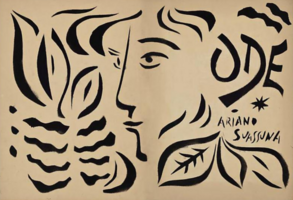Do objeto artístico único à reprodutibilidade industrial: Aloisio Magalhães e sua decisão pelo design
Este estudo tem como objeto de pesquisa a figura de Aloisio Maga¬lhães e seu estabelecimento no design. Acreditando que os problemas que tangem o campo podem sempre ser pensados à luz de suas colocações que, inegavelmente contemporâneas, mencionam os mesmos impasses ainda hoje não dissolvidos , este trabalho se ocupa, prioritariamente, de um período específico entre 1955-1965, momento em que os questionamentos do pernambucano em relação ao papel do artista contemporâneo começam a tomar corpo, culminando com a decisão integral pela atividade projetiva. Na pesquisa desta época quando, num vai-e-vem entre Brasil, Europa e Estados Unidos, Aloisio opta pelo abandono das artes plásticas, uma hipótese se mostra pertinente: teria sido a experiência norte-americana, vivida por ele, um divisor de águas? Teria sido ela a responsável por sua decisão de caminhar em outra direção? Antes de sua primeira viagem aos Estados Unidos, em 1956, o trabalho de Aloisio dividia-se entre as pinturas de sua produção pessoal e as ilustrações para as publicações feitas na oficina d O Gráfico Amador, em Recife, onde seu envolvimento era ainda muito mais voltado às artes plásticas. Observa-se que a experiência norte-americana marca Aloisio de maneira definitiva, aproximando-o dos ideais da Bauhaus e despertando-o para o encontro da arte e do projeto com a educação. A fim de analisar um processo que se locomoveu do objeto único ao múltiplo, da arte para poucos indivíduos ao projeto para muitos ambientado no mundo industrial contem¬porâneo, este estudo divide-se em três conjuntos. O primeiro capítulo apresenta uma breve introdução sobre a vida de Aloisio: os tempos iniciais no Recife, seu envolvimento com as artes plásticas, a experiência na oficina do artista gráfico americano Eugene Feldman, che-gando à opção pelo design decisão que se mostra condicionada ao direcionamento de seu pensamento em relação às artes, mas também à situação do cenário nacional. Tendo como ponto de partida o fortalecimento do design moderno nos Estados Unidos, durante os anos 1930, com a chegada de artistas europeus de formação bauhausiana, o segundo capítulo versa sobre o cenário norte-americano encontrado por Aloisio Magalhães entre os anos de 1956 e 1959. Ali, além de se revelar como possibilidade de união entre o exercício prático comercial, a teoria crítica e o ensino, o design também aflora em Aloisio a percepção de que já não cabe mais ao artista contemporâneo fazer objeto único, desligado de seu contexto social. Por fim, o terceiro capítulo aborda o escopo do discurso construtivo alemão que encanta Aloisio bem como a muitos designers americanos , e sua repercussão, levantando as questões envolvidas no terreno entre arte e indústria. Assim, na articulação destes três conjuntos, busca-se compreender não só as intenções de Aloisio ao se decidir pelo design, como também sua preocupação em construir um pensamento próprio quanto à formação do campo no Brasil. Apostando no diálogo da arte com a tecnologia industrial, Aloisio torna-se um artista verdadeiramente integrado a seu tempo.
The object of research of this dissertation is the Brazilian painter Aloisio Magalhães and his establishment as a designer in the early 1960 s. While one can believe that Brazilian design problems can always be thought under the light of his understandig still contemporary, and still bearing today the same unsolved impasses , this work deals with a specific period between 1955-1965. That is when Aloisio s questions on the role of contemporary artist began to take shape, culminating in his integral decision for the projective activity. Researching this period of time, when in a back-and-forth between Brazil, Europe and the United States, Aloisio chose to abandon the visual arts, a hypothesis is pertinent: would his North American experience, which he experienced, be a watershed? Was it responsible for his decision to move in another direction? Before his first trip to the United States in 1956, Aloisio's work was divided between the paintings of his personal production and the illustrations for the publications made at O Gráfico Amador, in Recife, where his involvement was still very much more geared towards the visual arts. It is quite clear that the American experience marks Aloisio definitely, bringing him closer to the Bauhaus ideals and to the merge of art and project within education. In order to analyze the process which has moved from the single object to the multiple industrialized object, from art made for the delight of few individuals to the design for many a people set in the contemporary industrial world, this study is divided into three sets. The first chapter presents a brief introduction of Aloisio s life: his initial times in Recife, his involvement with the visual arts, the experience in the workshop of the American graphic artist Eugene Feldman, arriving at his option for design a decision conditioned by the drive of his own thinking about the arts, but also about the situation of Brazilian national scene. The second chapter takes as a starting point the strengthening of modern design in the United States during the 1930s, with the arrival of European artists with Bauhaus formation. This chapter deals with the North American scenario found by Aloisio Magalhães between the years of 1956 and 1959. In addition to show off as a possibility of union between commercial practice, critical theory and teaching, design also reveals to Aloisio the perception that it was no longer up to the contemporary artist to make a single object, disconnected from its social context. Finally, the third chapter addresses the scope of German constructive discourse that enchants Aloisio as well as many American designers and its repercussion, raising issues involved in the field between art and industry. Thus, in the articulation of these three sets, it is sought to understand not only the intentions of Aloisio while deciding on design, but also his concern to construct a proper thought about the making of the field in Brazil. Betting on the dialogue of arts and industrial technology, Aloisio becomes a truly integrated artist at his time.
